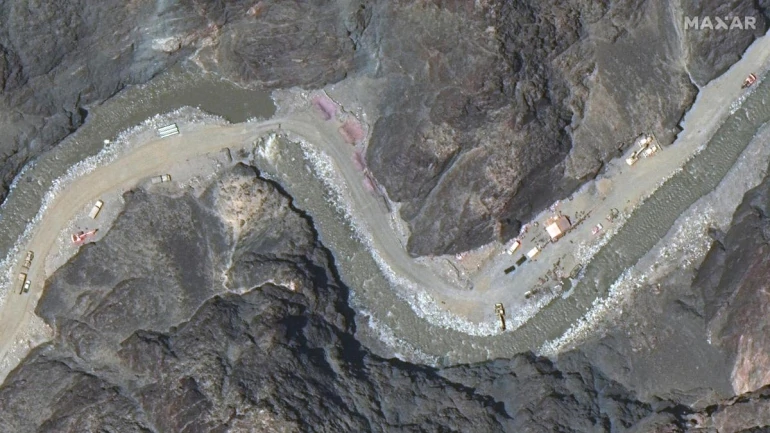
SOURCE: INDIA TODAY
India is not a pushover like the three Central Asian states of Kazakhstan, Kyrgyzstan and Tajikistan, with which China fixed boundary settlements in its favour though a blend of ‘incentives with coercion’ pressure tactics. In those situations, China started with its maximalist claim but settled for a minimalist demand to convey that it had compromised—given concessions to its counterparts—without actually losing an inch of territory. Yet its opponents were made to feel happy that they hadn’t lost everything.
Chinese ‘magnanimity’ actually made the Central Asians acquiesce to territorial concession to China in the 1990s. The last border settlement was with Tajikistan in 2011, when China claimed 28,000 sq. km but ‘settled’ for 1,158 sq. km, of land east of the Sarekole Mountains. The Tajiks had to cede land and were yet made to feel the victor. Even Russia has had to make tactical adjustments along its long border with China in favour of accepting changed strategic realities. But, the Chinese demographic foray continues in Kazakhstan and Russia’s Far East.
We know how Pakistan, in 1963, had to cede 2,050 sq. miles (5,180 sq. km) of its occupied part of the Baltistan/ Ladakh region to China in 1963, in exchange for 750 sq. miles of territory comprising the mineral rich Oprang Valley and the Darband-Darwaza from China. Yet, Pakistani leadership was made to say that the country had ceded no territory to China, and instead had to express gratitude for Premier Zhou Enlai’s generosity in ceding 750 sq. miles of territory to Pakistan.
For the first time, China’s border extends from the Kunlun Mountain range to the Karakoram Range to get the vast tract Gilgit-Baltistan region covering Shaksgam, Raskam and Aghil valleys, historically the grazing lands of the Mir of Hunza. But China’s border tactics are fuelling resentments across Asia. Even Pakistan is paying the price for its hasty decision to surrender J&K’s territory to China.
China’s border tactics offer some instructive examples, if not a cue for the future. But, so far, its tactics haven’t worked with India. After China failed to clinch a substantive concession from India through the 2005 draft agreement, it has started resorting to violent military tactics. In 2013, the People’s Liberation Army intruded 19 km into Depsang to press India, to show “urgency” and “redouble” efforts to settle the boundary issue.
China’s recent swoop in Ladakh is either to alter the status quo of Aksai Chin or to force India into a framework agreement to formally settle the border along the LAC in Ladakh, where China has nothing to lose. It is probable they also mistakenly assume that India has accepted the fait accompli of Aksai Chin.
By doing this, China wants India to forego its claim over the 38,000 sq km Aksai-Chin territory, thereby de-linking Ladakh from the overall boundary dispute. This is rather disturbing and if India falls for the Chinese trick to wrest Aksai Chin away militarily, Beijing will then shift the focus to emphatically claim 90,000 sq km of Arunachal from India.
The current situation in Ladakh remains extremely dangerous, if the status quo ante is not restored. The countries shouldn’t lose their strategic sight. Both President Xi and Prime Minister Modi should go back to where they left in Mahabalipuram. The investment they have made so far in building trust should not be allowed to go waste, and should instead be nurtured further.
Holding a meeting of the Working Mechanism for Consultation and Coordination on Border Affairs is a good move. Prime Minister Narendra Modi should be picking up from where then-Prime Minister Atal Bihari Vajpayee left off in 2003. The 2005 draft guiding principles still provides a definitive guide to realize an actual territorial adjustment. The two leaders are, in fact, well poised to go for a grand bargain to resolve the situation once and for all. To be sure, the Prime Minister gave a subtle message at the All Party Meeting. Despite all the criticism, he alone can find a lasting solution to the boundary issue.
But before India thinks about any bargain to be made, it needs to first consider that India’s claim over the Aksai Chin plateau has a history only from the early-19th century Dogra and British period. One has to consider that the Ladakh Kingdom’s traditional border run eastern along the Indus River to cover the areas of Rudok, Guge, Kailash, Burang, Gartok, up to the Nepal junction. Eastern Ladakh was taken militarily by the Tibetan-Mongol forces during Ladakh-Tibet war of 1679-1684. But for the timely military intervention by Aurangzeb and diplomatic intercession by Bhutan, all of Ladakh would have been a part of Tibet-China today.
The 1684 Temisgang Treaty defined the Ladakh-Tibet border, and also entitled the ruler of Ladakh to govern Menser Enclave, located at the foot of Mount Kailash. The Sikh, Dogra and British rulers respected the treaty. In fact, the Menser issue is not a closed one. We need to bring it to the table again. The area is roughly the same size as the 38,000 sq. km Aksai Chin, plus the 5,047 sq. km of Shaksgam Valley, and the Menser enclave is currently under China’s possession. It is almost certain the Chinese wouldn’t accede, for the area is strategically vital—connecting Tibet and Xinjiang through (G219), with Gar-Gunsa air base located here and the very important Mount Kailash being an important tourist destination. But for India, the area covering Kailash-Manasarovar is vital for its own civilisational identity. The great rivers of India the Brahmaputra, Ganges and Indus originate from here. Besides, getting the chicken-neck area of Parakarkyog, at the Ladakh-Himachal-Tibet junction, is crucial for realising an all-weather road to Ladakh.
https://defencenewsofindia.com/chinas-ladakh-gameplan/






